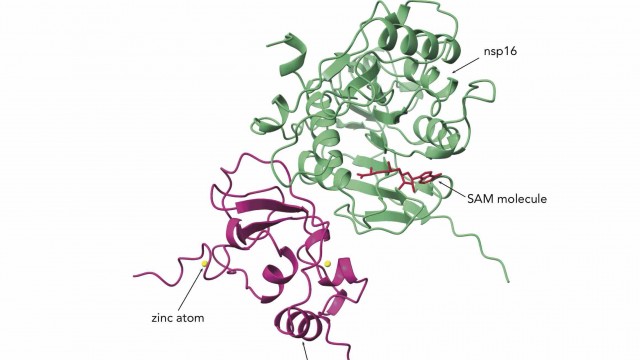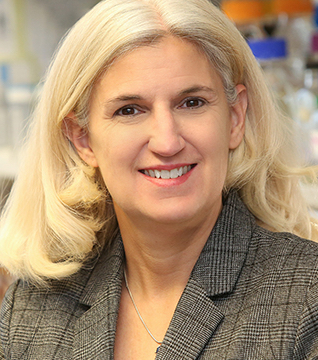March 20, 2020 I Jola Glotzer
NU team deciphers new COVID-19 protein complex
Hot off the press: Atomic structure of a novel SARS CoV-2 structural component, a protein complex called nsp10/16, mapped by NU scientists led by a CBC recent awardee, Karla Satchell
In a global race with time, scientists are rushing to learn as much as possible about SARS CoV-2 — the virus that causes COVID-19 — in order to develop therapeutics that could stop the pandemic. New local and international research collaborations are formed daily in this unprecedented effort to halt the spread of the virus and to help those already infected with it.
CBC-university scientists are contributing and working hard to resolve the SARS CoV-2 structure. Under the leadership of Karla Satchell, NU, director of Center for Structural Genomics of Infectious Diseases (CSGID), an international consortium of scientists is investigating the structure of the virus to aid drug development.
Their efforts recently resolved the atomic structure of a novel SARS CoV-2 protein complex — nsp10/16 — which plays a protective role in “hiding” the virus from the host immune system, and thus giving the virus time to multiply.
For more details on the COVID-19 nsp10/16 structure, please see the article by Marla Paul in Northwestern Now reposted below. The CBC congratulates Dr. Satchell and her collaborators on this important development that may contribute to identifying new drugs targeting the nsp10/16 complex.
March 19, 2020 | Marla Paul | Northwestern Now
New drug target found for COVID-19
Scientists discover critical protein that lets virus hide from immune system
A new potential drug target has been identified in SARS CoV-2 — the virus that causes COVID-19 — by scientists who say multiple drugs will likely be needed to respond to the pandemic.

Image of new drug target for COVID-19, a complex protein called nsp10/16. Source: Northwestern Now.
Scientists from Northwestern University Feinberg School of Medicine have mapped the atomic structure of two critical proteins in a complex, nsp10/16. These proteins modify the genetic material of the virus to make it look more like the host (human) cell RNA.
This allows the virus to hide from the cells, giving it time to multiply. If a drug can be developed to inhibit nsp10/nsp16, the immune system should be able to detect the virus and eradicate it faster.
“This is a really beautiful target, because it’s a protein absolutely essential for the virus to replicate,” said lead investigator Karla Satchell.
Satchell is a professor of microbiology-immunology at Northwestern and director of Center for Structural Genomics of Infectious Diseases (CSGID), an international consortium of scientists who are investigating the structure of the virus to aid drug development.
Satchell’s team is sending the new protein to Purdue University, the drug-discovery site of the center, to be screened for novel inhibitors that could be developed as new drugs.
The nsp10/nsp16 protein is called an RNA methyltransferase or MTase. It is comprised of two proteins bound together, which makes it more difficult to work with. The association of the two pieces together is required to make a functional protein, according to prior research on SARS.
The structure of nsp10/16 was released to the scientific community March 18 on the RSCB Protein Data Bank (www.rcsb.org).
This is the fourth protein structure of a potential drug target of SARS-CoV-2 determined by the CSGID team of scientists.
“We need multiple drugs to treat this virus, because this disease is likely to be with us for a long time,” Satchell said. “It’s not good enough for us to develop a single drug. If COVID-19 develops a resistance to one drug, then we need others.”
The center is racing to release more structures for drug development. The center’s goal is to determine structures of all of the proteins that are potential drug targets. The team also is collaborating to provide proteins to investigators for design of improved vaccines.
Data for this structure was collected at the Northwestern managed Life Sciences Collaborative Access Team beamline at the Advanced Photon Source at Argonne National Labs. The LS-CAT staff worked quickly with APS and Satchell to provide rapid access to the beamline over a weekend specifically to collect data for this project.
“The center has shown a great ability to bring structure biology to the scientific community at an unprecedented rate,” Satchell said. But their work has become more challenging because so many universities have reduced activities and some labs have shut down entirely.
“Our ability to do experiments is abating,” Satchell said. Still, the center will continue to release new structures until they reach their goal, she said.
Structures of three other proteins important for the replication of the virus have also been released: the nsp15 endonuclease, nsp3 ADP ribose phosphate and nsp9 replicase. These structures were determined by the center scientists at University of Chicago headed by professor Andrzej Joachimiak, Distinguished Fellow of Argonne, who also is an adjunct professor at Northwestern. All work conducted by both the University of Chicago and Northwestern teams was designed by the bioinformatic team of Adam Godzik at the University of California at Riverside, based on research conducted in SARS.
The CSGID is supported by a contract from the National Institute of Allergy and Infectious Diseases (NIAID), part of the National Institutes of Health, in part to serve as a response site to conduct structure biology research in the event of an unexpected infectious disease outbreak. NIAID has been working closely with the Center since early January to coordinate center activities with other research supported by NIAID to enable drug discovery.
This study has been funded by contract HHSN272201700060C from the National Institute of Allergy and Infectious Diseases, part of the NIH.
SOURCE:
Adapted (with modifications) from Northwestern Now, by Marla Paul, published on March 19, 2020.
SEE ALSO:
▸ The first unveiling of the COVID-19 coronavirus partial structure takes place in Chicago
Congratulations are due to a CBC affiliate, Andrzej Joachimiak, UChicago and Argonne National Laboratory and to recent CBC Accelerator Award recipient, Karla Satchell, NU
CBC Success Stories, March 10, 2020
▸ Investigating the New Coronavirus with Karla Satchell, PhD
Northwestern University Feinberg School of Medicine, Breakthroughs Podcasts
▸ New coronavirus protein reveals drug target
Argonne National Laboratory, Press Release, March 2, 2020
▸ New coronavirus protein, mapped in Chicago, reveals drug target
UChicago News, March 2, 2020
Featured CBC Community member:
Karla Satchell, NU
- CBC Accelerator Award (2019):
▸ RAS Processing as a Strategy to Reduce RAS-Driven Tumors
PI: Karla Fullner Satchell (NU) - CBC Postdoctoral Research Award (2015):
▸ Identifying Inhibitors of Novel Ras Bacterial Protease by High Throughput Screening
PIs: Marco Biancucci (postdoc) and Karla Fullner Satchell (NU)

